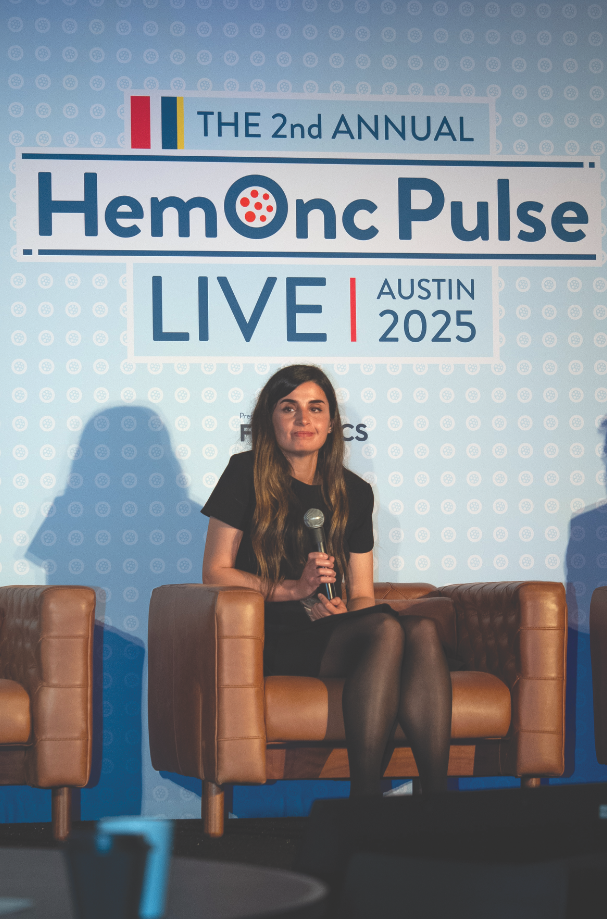
While research on CHIP has gained momentum in recent years, treating the premalignant condition remains in debate. However, clinicians are focusing on optimizing patient health, monitoring for disease progression, and managing the comorbidities associated with CHIP.
Clonal hematopoiesis of indeterminate potential (CHIP) refers to a biological process when a hematopoietic stem cell gains clonal potential from a mutation, providing it with a growth advantage over normal healthy cells.
“CHIP is considered preclinical, in that those who have CHIP may go on to develop a malignant condition in the future,” said Yael Kusne, MD, PhD, an Assistant Professor of Medicine at Mayo Clinic Arizona. “It is akin to monoclonal B cell lymphocytosis prior to development of chronic lymphocytic leukemia or monoclonal gammopathy of undetermined significance prior to development of multiple myeloma.”
Research on CHIP has gained momentum in recent years with the advancement of technology and has linked the preclinical condition to a variety of comorbidities. Blood Cancers Today spoke with several physicians and researchers about CHIP, research into the condition, recent developments, and remaining questions.
CHIP Gains Notice
As it is understood today, CHIP was first described in two large-scale clinical studies published on Christmas Day 2014 in the New England Journal of Medicine.
One study used whole-exome sequencing on data from more than 17,000 unselected individuals to look for somatic mutations in 160 genes that are mutated in hematologic cancers. They found that the presence of these mutations increased with age and was associated with an increased risk for hematologic cancer, all-cause mortality, incident coronary heart disease (CHD), and ischemic stroke.1
The second study used whole-exome sequencing of DNA from more than 12,000 individuals and found an increase in somatic mutations with age and increased risk for hematologic cancer.2
“It has been more than a decade now since CHIP was formally described, but it has not been well-described in the clinical literature until recently,” said Shyam Patel, MD, PhD, an Assistant Professor at UMass Chan Medical School.
CHIP became “well-described” in 2022 when researchers from the Wellcome-MRC Cambridge Stem Cell Institute and colleagues published the results of genome-wide analyses from more than 200,000 individuals in the United Kingdom (UK) Biobank that increased the number of germline associations with CHIP from four to 14, and again confirmed the association of CHIP with increased risk for myeloproliferative neoplasia, nonhematologic malignancies, and atrial fibrillation.3
“It took about eight years for CHIP to go from a pathophysiologic process to a clinically defined disease,” Dr. Patel said. “Now, we are seeing patients with CHIP on a regular basis because it is a recognized disease entity.”
In 2022, CHIP was included in both the 5th edition World Health Organization Classification (WHO-HAEM5) and the International Consensus Classification as a myeloid precursor lesion.4,5
How Is CHIP Diagnosed?
The definition of CHIP has evolved as technologies have advanced, explained Sanam Loghavi, MD, an Associate Professor of Pathology and Lab Medicine at The University of Texas MD Anderson Cancer Center.
“Age-related clonal hematopoiesis is defined as having a somatic mutation in a gene that is recurrently mutated in myeloid malignancies, but occurs in healthy individuals with no cytopenia, with a variant allele frequency (VAF) of ≥2%,” Dr. Loghavi said.
The most commonly mutated genes are DNMT3A, TET2, and ASXL1.6
“Somatic mosaicism is often age-related, but there are some data that shows that it can happen very early on in age,”7 Dr. Loghavi said. “If you look with very sensitive methods at individuals older than 40, almost everybody has clonal hematopoiesis. Some people might argue that it is an evolutionary mechanism to conserve hematopoiesis.”
CHIP was first recognized in healthy individuals because researchers were looking for these mutations in large-scale cohorts. In the real-world setting, people are often diagnosed with CHIP because their blood is getting sequenced for other reasons, Dr. Loghavi explained.
“The field of CHIP has evolved to include two broad categories; one is truly age-related clonal hematopoiesis or CHIP in a healthy individual who will probably go on to live life without ever developing myeloid neoplasms,” Dr. Loghavi said. “The other is referred to as context-dependent CHIP. These are often discovered in someone with another type of cancer who may get exposed to chemotherapy or have other predisposing conditions that may ‘fuel the fire’ and increase the risk for developing myeloid neoplasms.”
Comorbidity Risk
Studies have shown CHIP to be linked with a plethora of other comorbid conditions. “There are at least six different nonhematologic diseases for which CHIP is an independent risk factor,” Dr. Patel said.
In 2017, Siddhartha Jaiswal, MD, PhD, of Stanford University School of Medicine, and colleagues published the results of their whole-exome sequencing analysis looking for associations between CHIP in peripheral blood cells and CHD. Using samples from four case-control studies including more than 4,000 individuals, they found that CHIP was associated with an almost twofold increased risk for CHD compared to noncarriers of CHIP. Mutations in DNMT3A, TET2, ASXL1, and JAK2 were individually associated with CHD.8
More recently, a study of individuals from the Jackson Heart Study and the Women’s Health Initiative showed a more than twofold higher risk for incident heart failure with preserved ejection fraction among those with TET2 CHIP.9
In 2023, researchers from the TOPMed Diabetes Working Group and National Heart, Lung, and Blood Institute TOPMed Consortium published results of a whole-genome sequencing study of blood DNA taken from more than 17,500 individuals without prior type 2 diabetes, cardiovascular disease, or cancer. Baseline CHIP was associated with a 23% higher risk for type 2 diabetes. Specifically, risk was higher in those with TET2 (hazard ratio [HR]=1.48), and ASXL1 (HR=1.76) mutations.10
Because CHIP was linked with cardiovascular disease, researchers also looked at the association between CHIP and another age-related inflammatory process: chronic obstructive pulmonary disease (COPD). After analyzing data from almost 50,000 individuals, the researchers established associations between CHIP and the presence and severity of COPD.11
A recently published study using data from the UK Biobank established a link between CHIP and the risk for neurodegenerative diseases such as vascular neurodegenerative diseases (HR=1.31) and amyotrophic lateral sclerosis (ALS; HR=1.50). This increased risk was mainly seen with DNMT3A, ASXL1, or SRSF2 mutations.12
Other studies have linked CHIP to increased incident osteoporosis diagnosis and decreased bone mineral density,13 gout,14 chronic kidney disease,15 and acute kidney injury.16
Now What?
For individuals with CHIP, nothing can be done to change the natural history of the identified mutation, said Catherine C. Coombs, MD, an Associate Clinical Professor at the University of California, Irvine.
“When I see a patient referred for [CHIP], I explain the common nature of having such mutations but note that there are no proven strategies to reduce or eliminate these clones,” Dr. Coombs said. “However, CHIP does have other health implications, such as increased risk for CVD mortality, and we can optimize health from a cardiac standpoint.”
This optimization of modifiable risk factors typically involves working with a cardiologist or a primary care provider to help patients optimize blood pressure and lipids and to adopt healthy lifestyle behaviors such as increasing exercise or losing weight if needed.
When referred to a patient with CHIP who also has a solid tumor, Dr. Coombs said that the CHIP diagnosis only occasionally changes her recommendations for cancer treatment.
“This will depend on the strength of evidence for the treatment they are getting, if they have active disease, if the therapy is being given adjuvantly, and how high of a risk mutation they have,” Dr. Coombs said.
For example, Dr. Coombs was referred a patient with CHIP who had a TP53 mutation with VAF of 20%. This patient was on a PARP inhibitor to treat ovarian cancer, but did not have a BRCA mutation.
“Because there was no BRCA mutation, the benefit of adjuvant therapy with a PARP inhibitor is low, but we do know that a PARP inhibitor can lead to increased risk of therapy-related myeloid neoplasms,” Dr. Coombs said. “In conjunction with the patient’s gynecological oncologist, we made the recommendation that continuing the PARP inhibitor may be of more harm than good.”
If a patient has CHIP and is getting chemotherapy, there is a higher risk of therapy-related myeloid neoplasms, Dr. Coombs said. This should help inform the risk-benefit discussion, but “in the end, you have to deal with the cancer you know you have as opposed to one you might get,” Dr. Coombs said.
For healthy individuals with CHIP, monitoring for progression to a hematologic malignancy is a watchful waiting strategy, Dr. Coombs said.
However, there are tools that allow clinicians to estimate risk for development of a myeloid neoplasm.
Establishing Risk
“The clonal hematopoiesis risk score [CHRS] takes information about the patient and uses a computational algorithm to stratify patients into low-, intermediate-, or high-risk,” said Dr. Kusne. “This allows us to provide patients with a general idea of their risk for developing blood cancers in the future.”
In 2023, Lachelle Weeks, MD, PhD, of the Dana-Farber Cancer Institute, and colleagues performed an analysis on sequenced exomes of more than 400,000 healthy individuals from the UK Biobank to develop the CHRS, which was then validated in cohorts of patients with CHIP or clonal cytopenia of undetermined significance (CCUS)—CHIP in the presence of unexplained cytopenia. The risk score used factors such as single DNMT3A mutations, high-risk mutations, having two or more mutations, a VAF ≥20%, age ≥65, red blood cell indices, and more.17
The majority (88.4%) of individuals were defined as low-risk. Most myeloid neoplasms eventually developed in those considered high-risk.
“This was based on samples in the UK Biobank from healthy individuals, and retrospectively looked at people who developed myeloid neoplasm to construct the risk score,” Dr. Loghavi said. “This does not necessarily apply in the context-dependent setting.”
Dr. Patel acknowledged that in a real-world setting, most cases of clonal hematopoiesis are diagnosed in the presence of cytopenias. To address this, Dr. Patel and colleagues conducted a study attempting to characterize the clinical trajectories of patients with clonal hematopoiesis who had a clinical indication for CHIP testing in the first place.18
“We found slightly different results,” Dr. Patel said. “In our analysis, the predictors of progression were presence of nonDNMT3A/TET2/ASXL1 mutations, high VAF, and presence of RUNX1 mutation. These factors conferred high relative risk for progression.”
In this analysis, RUNX1 mutations had the strongest risk for progression to myeloid neoplasm (odds ratio=10.27), and mean VAF across all genes was higher in those who progressed than in those who did not.18
Another real-world study published in Blood earlier this year developed a three-parameter Clonal Cytopenia Risk Score (CCRS)—the presence of splicing mutation(s) (score=2 points), platelet count <100×109/L (score=2.5), and ≥2 mutations (score=3)—and stratified patients into low- (score<2.5 points), intermediate- (score 2.5-<5), and high-risk (score≥5) groups.19 This CCRS predicted the two-year cumulative incidence of development of myeloid neoplasms, with high-risk groups having a 37.2% risk.
“The utility of risk assessment is knowledge for the clinician and the patient,” Dr. Patel said. “It can help them plan accordingly.”
Dr. Coombs agreed, “If you have a detail-oriented patient, you can do these models in front of them to help them understand what their risk is.”
What Can Be Done?
“Whether patients with high-risk CHIP who also have blood count abnormalities—CCUS—should be treated prior to hematologic malignancy remains in debate,” Dr. Kusne said. “There are clinical trials for this currently.”
The IMPACT study is investigating canakinumab, a monoclonal antibody targeting interleukin-1β, for CCUS.20 Memorial Sloan Kettering has a pilot study of the IDH2 inhibitor enasidenib in patients with CCUS and IDH2 mutations.21 Similarly, researchers at Washington University School of Medicine have launched a trial of the IDH1 inhibitor ivosidenib in patients with CCUS and mutations in IDH1.22
At the CHIP Clinic at Stanford Medicine, Tian Yi Zhang, MD, PhD, an Assistant Professor of Medicine, is hoping to launch a clinical trial investigating whether magrolimab can prevent the development of acute myeloid leukemia in patients with therapy-related TP53 CHIP mutation.23
Data presented at the European Hematology Association 2024 Hybrid Congress detailed a randomized study on the use of vitamin C supplementation in patients with low-risk myeloid malignancies or CCUS, with preliminary results showing “significantly longer overall survival” in the vitamin C supplementation group.24
“With a small study, sometimes you get lucky with your results and find something significant even when it is not the primary endpoint,” Dr. Coombs said. “The full paper on this is not out yet, but there could be something to the vitamin C story.”
Unanswered Questions
Despite recent progress, many unanswered questions remain.
Dr. Patel said one area of interest is whether artificial intelligence could identify patterns of specific mutations that predict the development of myeloid neoplasms.
“There are so much raw clinical data in terms of genomics, but it is hard to analyze manually,” Dr. Patel said. “It would be interesting to see if there was a way to use an automated pipeline to analyze this genetic information to predict the likelihood and timeframe of myeloid neoplasms development.”
Another important question is whether there are effective interventions to change the natural history, specifically as it relates to hematologic malignancies and cardiovascular disease, Dr. Coombs said.
“I am aware of these studies for CHIP, but another big question is who should we be checking to identify patients to enroll in these studies,” Dr. Coombs said. “We don’t want to check everyone because that would be a huge financial cost and a lot of unnecessary anxiety.”
Dr. Patel also said that he would like to see the development of evidence-based or expert-consensus guidelines for the management of patients with CHIP, and the hematologic and nonhematologic conditions associated with CHIP.
“Implementation of formalized clinical guidelines on CHIP would help patients and might be a big step forward in terms of large-scale population health,” Dr. Patel said. “Guidelines may also help determine whether to screen stem cell transplant donors for CHIP, which affects population health in large-scale.”
In fact, a recent meta-analysis examined a series of studies looking at the effects of donor-engrafted clonal hematopoiesis in patients undergoing allogeneic and autologous hematopoietic stem cell transplantation (HSCT).
Using data from five allogeneic HSCT studies and nine autologous HSCT studies, Dr. Patel and colleagues found that pretransplant clonal hematopoiesis among patients undergoing autologous HSCT was associated with worse overall survival (hazard ratio [HR]=1.30), progression-free survival (HR=1.35), and higher risk for therapy-related myeloid neoplasms (HR=4.85).
“When using stem cell donor in the allogeneic setting, there was no adverse impact imparted by donor-derived clonal hematopoiesis upon the recipient,” Dr. Patel said.
Clonal hematopoiesis after HSCT decreased risk of relapse, but had no effect on survival outcomes.
“With this meta-analysis, there were clearly inferior outcomes in autologous [HSCT] setting,” Dr. Patel said. “Our study suggests that it is probably worth screening autologous [HSCT] recipients for clonal hematopoiesis.”
Lastly, as Dr. Kusne pointed out, the biology of CHIP has not been completely elucidated.
“While we know why some clones grow over others—for instance, clones with DNA damage repair pathway mutations gain growth advantage from chemotherapy and radiation—the mechanisms behind how these clones interact and impact their environment is not yet clear,” Dr. Kusne said. “In time, with the continual improvement of our technologies, we will be able to answer more of these questions and perhaps determine when and how to intervene.”
Leah Lawrence is a freelance health writer and editor based in Delaware.
References
1. Jaiswal S, Fontanillas P, Flannick J, et al. Age-Related Clonal Hematopoiesis Associated with Adverse Outcomes. N Engl J Med. 2014;371:2488-2498. doi:10.1056/NEJMoa1408617
2. Genovese G, Kähler AK, Handsaker RE, et al. Clonal Hematopoiesis and Blood-Cancer Risk Inferred from Blood DNA Sequence. N Engl J Med. 2014;371:2477-2487. doi:10.1056/NEJMoa1409405
3. Kar SP, Quiros PM, Gu M, et al. Genome-wide analyses of 200,453 individuals yield new insights into the causes and consequences of clonal hematopoiesis. Nat Genet. 2022 Aug;54(8):1155-1166. doi:10.1038/s41588-022-01121-z.
4. Khoury JD, Solary E, Abla O, et al. The 5th edition of the World Health Organization Classification of Haematolymphoid Tumours: myeloid and Histiocytic/Dendritic neoplasms. Leukemia. 2022;36(7):1703–1719. doi:10.1038/s41375-022-01613-1
5. Arber DA, Orazi A, Hasserjian RP, et al. International Consensus classification of myeloid neoplasms and Acute Leukemias: integrating morphologic, clinical, and genomic data. Blood. 2022;140(11):1200–1228. doi:10.1182/blood.2022015850
6. Feldkamp JD, Vetter VM, Arends CM, et al. Clonal hematopoiesis of indeterminate potential-related epigenetic age acceleration correlates with clonal hematopoiesis of indeterminate potential clone size in patients with high morbidity. Haematologica. 2022 Jul 1; 107(7): 1703–1708. doi:10.3324/haematol.2021.280021
7. Machado HE, Øbro NF, Williams N, et al. Convergent somatic evolution commences in utero in a germline ribosomopathy. Nat Commun. 2023 Aug 22;14(1):5092. doi:10.1038/s41467-023-40896-5.
8. Jaiswal S, Natarajan P, Silver AJ, et al. Clonal Hematopoiesis and Risk of Atherosclerotic Cardiovascular Disease. N Engl J Med. 2017;377:111-121. doi:10.1056/NEJMoa1701719
9. Schuermans A, Honigberg MC, Raffield LM, et al. Clonal Hematopoiesis and Incident Heart Failure With Preserved Ejection Fraction. JAMA Network Open. 2024;7(1):e2353244. doi:10.1001/jamanetworkopen.2023.53244.
10. Tobias DK, Manning AK, Wessel J, et al. Clonal Hematopoiesis of Indeterminate Potential (CHIP) and Incident Type 2 Diabetes Risk. Diabetes Care. 2023 Nov 1;46(11):1978-1985. doi:10.2337/dc23-0805.
11. Miller PG, Qiao D, Rojas-Quintero J, et al. Association of clonal hematopoiesis with chronic obstructive pulmonary disease. Blood. 2022; 139(3): 357–368. doi:10.1182/blood.2021013531.
12. Kim PG, Niroula A, Shkolnik A, et al. Dnmt3a-mutated clonal hematopoiesis promotes osteoporosis. J Exp Med. 2021 Dec 6; 218(12): e20211872. doi:10.1084/jem.20211872.
13. Liu X, Xue H, Wirdefeldt K, et al. Clonal hematopoiesis of indeterminate potential and risk of neurodegenerative diseases. J Intern Med. 2024 Jul 29. doi:10.1111/joim.20001. Online ahead of print.
14. Agrawal M, Niroula A, Cunin P, et al. TET2-mutant clonal hematopoiesis and risk of gout. Blood. 2022; 140(10): 1094–1103. doi:10.1182/blood.2022015384.
15. Vlasschaert C, McNaughton AJM, Chong M, et al. Association of Clonal Hematopoiesis of Indeterminate Potential with Worse Kidney Function and Anemia in Two Cohorts of Patients with Advanced Chronic Kidney Disease. J Am Soc Nephrol. 2022; 33(5): 985–995. doi:10.1681/ASN.2021060774.
16. Vlasschaert C, Robinson-Cohen C, Chen J, et al. Clonal hematopoiesis of indeterminate potential is associated with acute kidney injury. Nat Med. 2024 Mar;30(3):810-817. doi:10.1038/s41591-024-02854-6
17. Weeks LD, Niroula A, Neuberg D, et al. Prediction of risk for myeloid malignancy in clonal hematopoiesis. NEJM Evid. 2023;2(5):10.1056/evidoa2200310. doi:10.1056/evidoa2200310.
18. Patel SA, Gerber WK, Zheng R, et al. Natural history of clonal haematopoiesis seen in real-world haematology settings. Br J Haematol. 2024 May;204(5):1844-1855. doi:10.1111/bjh.19423.
19. Xie Z, Komrokji RS, Al-Ali N, et al. Risk Prediction for Clonal Cytopenia: Multicenter Real-World Evidence. Blood. 2024. doi10.1182/blood.2024024756.
20. A Pilot Study of Enasidenib in People With Clonal Cytopenia of Undetermined Significance and Mutations in IDH2. CLINICALTRIALS.GOV IDENTIFIER: NCT05102370.
21. Ivosidenib for Patients With Clonal Cytopenia of Undetermined Significance and Mutations in IDH1. CLINICALTRIALS.GOV IDENTIFIER: NCT05030441.
22. Canakinumab for the Prevention of Progression to Cancer in Patients with Clonal Cytopenias of Unknown Significance, IMPACT Study. CLINICALTRIALS.GOV IDENTIFIER: NCT05641831.
23. Stanford Medicine. The CHIP Clinic at Stanford Medicine. https://medicalgiving.stanford.edu/giving-opportunities/The-CHIP-Clinic-at-Stanford-Medicine.html. Accessed September 11, 2024.
24. Mikkelsen SU, Vallentin A, Nielsen A, et al. Vitamin C supplementation in patients with clonal cytopenia of undetermined significance or low-risk myeloid malignancies: results from EVI-2, a randomized, placebo-controlled phase 2 study. Abstract #LB3444. Presented at the European Hematology Association 2024 Hybrid Congress; June 13-16, 2024; Madrid, Spain.
25. Xie Y, Kazakova V, Weeks LD, et al. Effects of donor-engrafted clonal hematopoiesis in allogeneic and autologous stem cell transplantation: a systematic review and meta-analysis. Bone Marrow Transplant. 2024. doi:10.1038/s41409-024-02403-2.






 © 2025 Mashup Media, LLC, a Formedics Property. All Rights Reserved.
© 2025 Mashup Media, LLC, a Formedics Property. All Rights Reserved.